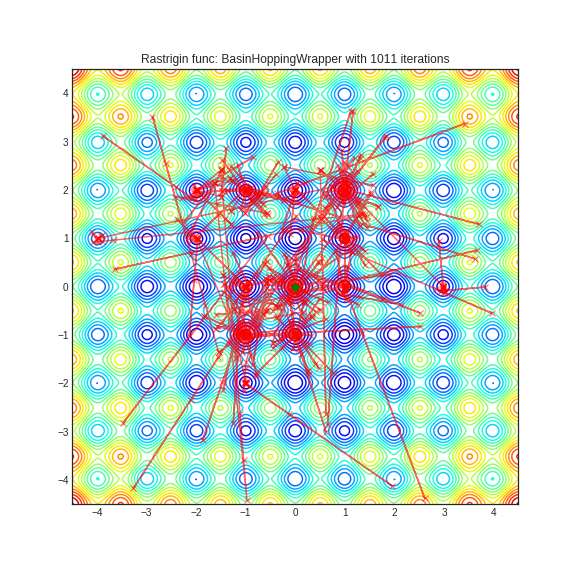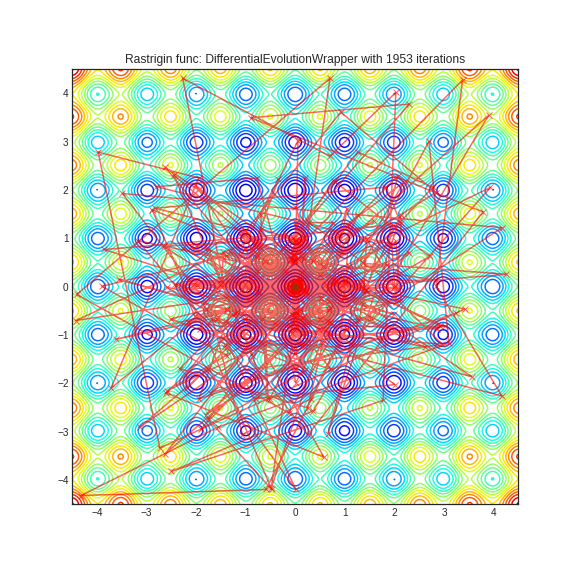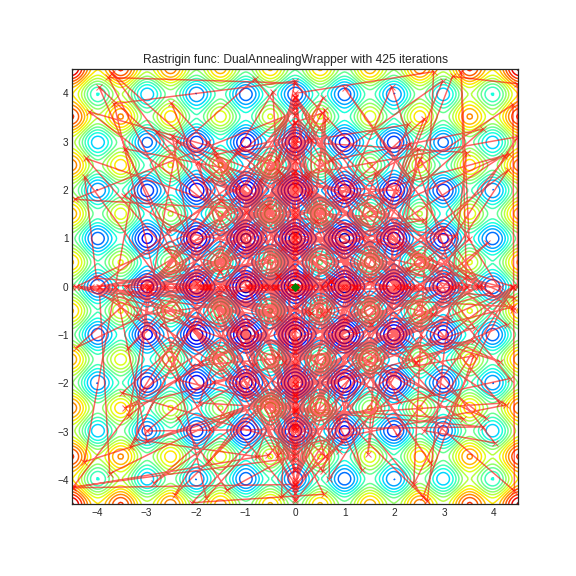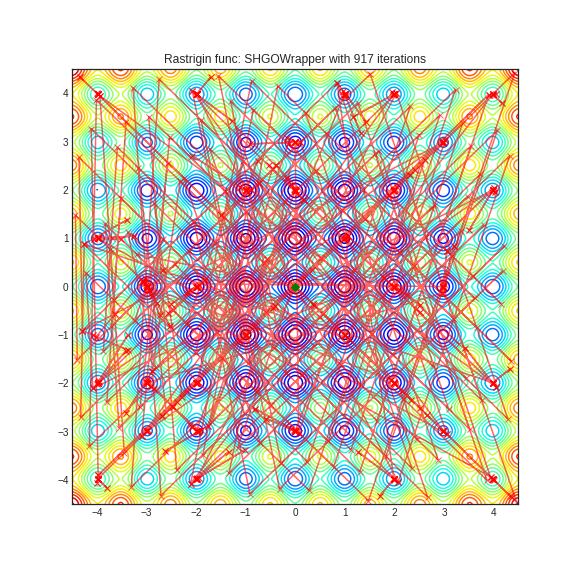A wrapper for scipy.optimize.minimize to make it a PyTorch
Optimizer implementing Conjugate Gradients, BFGS, l-BFGS, SLSQP, Newton
Conjugate Gradient, Trust Region methods and others in PyTorch.
Warning: this project is a proof of concept and is not necessarily reliable, although the code (that's all of it) is small enough to be readable.
- Quickstart
- Which Algorithms Are Supported?
- Global Optimizers
- How Does it Work?
- How Does This Evaluate the Hessian?
- Credits
Dependencies:
pytorchscipy
The following install procedure isn't going to check these are installed.
This package can be installed with pip directly from Github:
pip install git+https://github.com/gngdb/pytorch-minimize.git
Or by cloning the repository and then installing:
git clone https://github.com/gngdb/pytorch-minimize.git
cd pytorch-minimize
python -m pip install .
The Optimizer class is MinimizeWrapper in pytorch_minimize.optim. It
has the same interface as a PyTorch Optimizer, taking
model.parameters(), and is configured by passing a dictionary of
arguments, here called minimizer_args, that will later be passed to
scipy.optimize.minimize:
from pytorch_minimize.optim import MinimizeWrapper
minimizer_args = dict(method='CG', options={'disp':True, 'maxiter':100})
optimizer = MinimizeWrapper(model.parameters(), minimizer_args)
The main difference when using this optimizer as opposed to most PyTorch
optimizers is that a closure (torch.optim.LBFGS also
requires this) must be defined:
def closure():
optimizer.zero_grad()
output = model(input)
loss = loss_fn(output, target)
loss.backward()
return loss
optimizer.step(closure)
This optimizer is intended for deterministic optimisation problems,
such as full batch learning problems. Because of this,
optimizer.step(closure) should only need to be called once.
Can .step(closure) be called more than once? Technically yes, but it
shouldn't be necessary because multiple steps are run internally up to the
maxiter option in minimizer_args and multiple calls are not
recommended. Each call to optimizer.step(closure) is an independent
evaluation of scipy.optimize.minimize, so the internal state of any
optimization algorithm will be interrupted.
Using PyTorch to calculate the Jacobian, the following algorithms are supported:
- Conjugate Gradients:
'CG' - Broyden-Fletcher-Goldfarb-Shanno (BFGS):
'BFGS' - Limited-memory BFGS:
'L-BFGS-B'but requires double precision:nn.Modulecontaining parameters must be cast to double, example:model = model.double()
- Sequential Least Squares Programming:
'SLSQP' - Truncated Newton:
'TNC'but also requires double precision
The method name string is given on the right, corresponding to the names used by scipy.optimize.minimize.
Warning: this is experimental and probably unpredictable.
To use the methods that require evaluating the Hessian, a Closure object
with the following methods is required (full MNIST example
here):
class Closure():
def __init__(self, model):
self.model = model
@staticmethod
def loss(model):
output = model(data)
return loss_fn(output, target)
def __call__(self):
optimizer.zero_grad()
loss = self.loss(self.model)
loss.backward()
return loss
closure = Closure(model)
The following methods can then be used:
- Newton Conjugate Gradient:
'Newton-CG' - Newton Conjugate Gradient Trust-Region:
'trust-ncg' - Krylov Subspace Trust-Region:
'trust-krylov' - Nearly Exact Trust-Region:
'trust-exact' - Constrained Trust-Region:
'trust-constr'
The code contains hacks to make it possible to call torch.autograd.functional.hessian (which is itself only supplied in PyTorch as beta).
If using the scipy.optimize.minimize algorithms that don't require
gradients (such as 'Nelder-Mead', 'COBYLA' or 'Powell'), ensure that
minimizer_args['jac'] = False when instancing MinimizeWrapper.
Algorithms I tested didn't converge on a toy problem or hit errors. You can still select them but they may not work:
- Dogleg:
'dogleg'
All the other methods that require gradients converged on a toy problem that is tested in Travis-CI.
There are a few global optimization algorithms in
scipy.optimize. The following are supported via their own
wrapper classes:
- Basin Hopping via
BasinHoppingWrapper - Differential Evolution via
DifferentialEvolutionWrapper - Simplicial Homology Global Optimization via
SHGOWrapper - Dual Annealing via
DualAnnealingWrapper
An example of how to use one of these wrappers:
from pytorch_minimize.optim import BasinHoppingWrapper
minimizer_args = dict(method='CG', options={'disp':True, 'maxiter':100})
basinhopping_kwargs = dict(niter=200)
optimizer = BasinHoppingWrapper(model.parameters(), minimizer_args, basinhopping_kwargs)
These are also illustrated in this colab notebook, where the following plots were generated:
scipy.optimize.minimize is expecting to receive a function fun that
returns a scalar and an array of gradients the same size as the initial
input array x0. To accomodate this, MinimizeWrapper does the following:
- Create a wrapper function that will be passed as
fun - In that function:
- Unpack the umpy array into parameter tensors
- Substitute each parameter in place with these tensors
- Evaluate
closure, which will now use these parameter values - Extract the gradients
- Pack the gradients back into one 1D Numpy array
- Return the loss value and the gradient array
Then, all that's left is to call scipy.optimize.minimize and unpack the
optimal parameters found back into the model.
This procedure involves unpacking and packing arrays, along with moving back and forth between Numpy and PyTorch, which may incur some overhead. I haven't done any profiling to find out if it's likely to be a big problem and it completes in seconds when optimizing a logistic regression on MNIST by conjugate gradients.
There are a few other projects that incorporate scipy.optimize and
pytorch:
- This gist I wrote in 2018 then forgot about creates an
Objective object to pass into
scipy.optimizebut packs the arrays and gradients in approximately the same way. - botorch's
gen_candidates_scipywrapsscipy.optimize.minimizeand uses it to optimize acquisition functions as part of Bayesian Optimization. - autograd-minimize wraps the
minimizefunction itself, allowing PyTorch or Tensorflow objectives to be passed directly to a function with the same interface asscipy.optimize.minimize.
rfeinman has implemented some of the algorithms available in scipy.optimize
in a repository with the same name as this repository. That
implementation is much more efficient and avoids switching between
32 and 64 bit floats between Numpy and PyTorch.
That repository also contains a wrapper around scipy.optimize.minimize.
To evaluate the Hessian in PyTorch,
torch.autograd.functional.hessian takes two arguments:
func: function that returns a scalarinputs: variables to take the derivative wrt
In most PyTorch code, inputs is a list of tensors embedded as parameters
in the Modules that make up the model. They can't be passed as inputs
because we typically don't have a func that will take the parameters as
input, build a network from these parameters and then produce a scalar
output.
From a discussion on the PyTorch forum the only way to calculate
the gradient with respect to the parameters would be to monkey patch
inputs into the model and then calculate the loss. I wrote a recursive
monkey patch that operates on a deepcopy of the original
model. This involves copying everything in the model so it's not very
efficient.
The function passed to scipy.optimize.minimize as hess does the
following:
copy.deepcopythe entiremodelModule- Input
xis a Numpy array so cast it to tensor float32 andrequire_grad - Define a function
fthat unpacks this 1D Numpy array into parameter tensors- Recursively navigate the module object
- Deleting all existing parameters
- Replacing them with unpacked parameters from step 2
- Calculate the loss using the static method stored in the
closureobject
- Recursively navigate the module object
- Pass
ftotorch.autograd.functional.hessianandxthen cast the result back into a Numpy array
If you use this in your work, please cite this repository using the following Bibtex entry, along with Numpy, Scipy and PyTorch.
@misc{gray2021minimize,
author = {Gray, Gavia},
title = {PyTorch Minimize},
year = {2021},
publisher = {GitHub},
journal = {GitHub repository},
howpublished = {\url{https://github.com/gngdb/pytorch-minimize}}
}
This package was created with Cookiecutter and the
audreyr/cookiecutter-pypackage project template.



